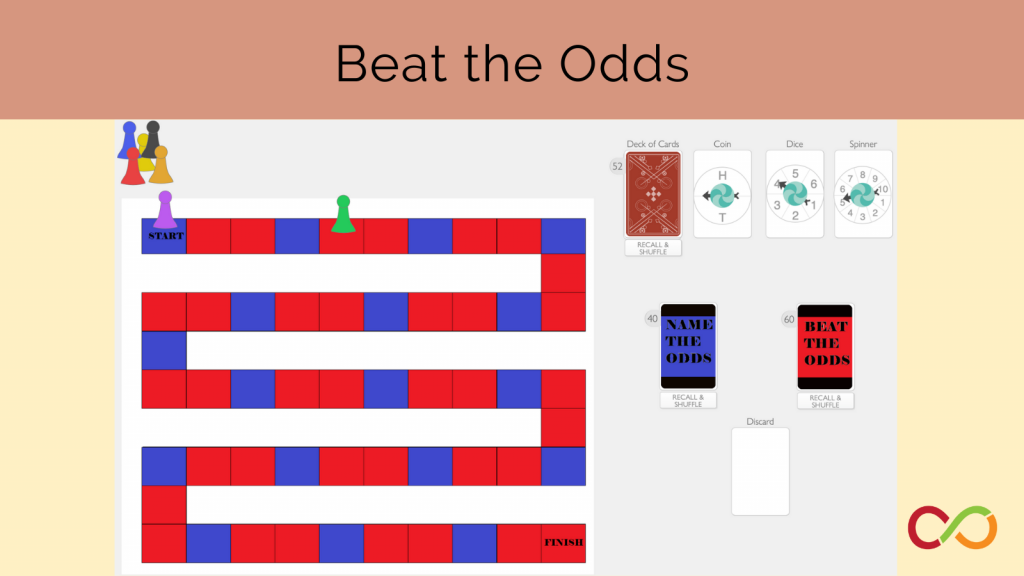Beat The Odds
Junior (Age 9 – 12)
Curriculum Goal
Junior: Data Management
- Describe the likelihood that events will happen and use that information to make predictions.
- Determine and compare the theoretical and experimental probabilities of an event happening.
Context
- Play in small groups of two to five students.
- Students should have previous experience determining the theoretical and experimental probabilities of an event’s occurrence.
Materials
In-person version
- Game Board (Appendix A)
- Game Cards (Appendix B)
- Game pieces for each student (Appendix C)
- Deck of Cards
- Coin
- Dice
- Spinner (Appendix D)
Online version
- Game file (Playingcards.io upload instructions)
- Video conference capabilities
Lesson
- To begin, all players will choose a game piece and place it on the blue “start” square.
- On each player’s turn, they will draw a card that matches the colour of the square their game piece is on. If the player is on a blue square, they will draw a “Name the Odds” card. If the player is on a red square, they will draw a “Beat the Odds” card.
- Because each player begins the game on the blue “start” square, players will draw a “Name the Odds” card on their first turn.
- “Name the Odds” cards provide an event and ask the players to name the likelihood of that event happening in the form of a fraction. Players can reference the spinner, dice, and coin additions to help them answer the question.
- Have the player to the right of the student that is taking their turn read the “Name the Odds” card, and verify the answer written on the bottom of the card.
- If the player answers correctly, they will advance the corresponding number of squares listed on the card. If the player answers incorrectly, they will remain on the initial square. Then the next player takes their turn.
- If the player advances to a red square, they will draw a “Beat the Odds” card on their next turn. This card provides an event and challenges players to beat the odds by using the spinner, dice, coin, or card additions.
- If the player can beat the odds, they will advance the corresponding number of squares listed on the card. If the player cannot beat the odds, they stay where they are on the game board and draw a “Beat the Odds” card on their next turn.
- The game play continues with players taking turns and following the instructions on the cards. The player to reach the “Finish” square first, wins!

Look Fors
- What strategies do students use to Name the Odds (e.g., do they reference the dice, spinner, and/or coin)?
- Do students suggest differences about the theoretical probability of the event occurring compared to the experimental probability of the events occurrence (e.g., Do students recognize the results of their turn are expected/unexpected based on the experimental probability of that event)?
Extension
- Students can create their own “Beat the Odds” and “Name the Odds” event cards.
- If students do not beat the odds on their first try, have them continue trying until they do and make note of the experimental probability of the events occurrence.
Created by Kathryn Farrell. Adapted by The Robertson Program.
Share this lesson
Share on facebook
Share on twitter
Share on email
